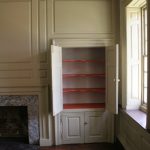We may receive a commission when you use our affiliate links. However, this does not impact our recommendations.

Don Weber’s Bicycle Lathe article in the August 2007 issue (#163) has sparked a lot of interest and questions. So below, Don has provided answers to some of the repeat questions. He’s also working on a plan drawing for constructing a bicycle lathe; we’ll let you know as soon as the plan is available, and how you can get it.
Concerning shaft dimension and fittings: I used a 1″ cold-rolled steel shaft procured from my local machine shop. Any 1″-diameter shaft will do; it fits a standard pillow block available from most hardware stores. The bicycle sprocket, purchased from my local bike shop, is a standard 13-tooth, single-gear sprocket. I had our local machinist turn a collet for me to thread into the fine threaded hole in the sprocket, leaving enough collar to drill and tap for a Ã?¼” 20 set screw. You can turn your own collet from hardwood (I’ve made one from Lignnum Vitae), but steel will last longer.
The attachments for the flywheel and faceplate, or grinding wheel attachment, were 1-1/2″ floor flanges with a 1″ reducer. The extra reducer allowed me to drill and tap for the 1/4″ 20 set screw. The floor flange does not have enough shoulder to accommodate a set screw. I had to drill out the threads in the reducer with a 1″ drill on the drill press. I did this by screwing the flange and reducer to a scrap of plywood, then clamping the plywood to the drill-press table. It made holding the reducer more secure and safe. It also helped to keep the bore true to the shaft.
For other questions regarding the lathe, e-mail Don Weber (dbodger@kyblue.com) – and we’ll let you know soon about plan availability.
– Megan Fitzpatrick
Here are some supplies and tools we find essential in our everyday work around the shop. We may receive a commission from sales referred by our links; however, we have carefully selected these products for their usefulness and quality.









I just dug up my old issue and found this article because i was thinking about building one of these to turn some chair legs. First of all, the bicycle sprocket is actually called a freewheel. Also, I was wondering if you had posted any plans as of yet because I can’t find them.
Well, I’m still in the dark. I love the concept, but the critical mechanical part is the one thing not well descriped or diagramned. How do the sprocket, the collet, and the shaft interact to transfer mechanical energy in one direction but spin freely in the other?
A bicycle uses a centrifugal crank to achieve this, but that is not the part(s) you used. I suspect it is very simple and I am just not getting it, but I anxiously await the drawings. It would be helpful if there were an off the shelf equivalent that did not require custom work at a machine shop.
When I first started reading this article, I liked it right away. Some time down the road, I hope to make something similar.
Central American countries are not the only nations with spotty distribution of electricity. There are some isolated areas in the Philippines, mostly in the southern island of Mindanao, where electrification has yet to happen. Along with microfinancing programs, this kind of technology is what’s badly needed to help folks enter the economic life of their villages, provinces, and nations.
This technology is also in the spirit of E.F. Schumacher’s book Small Is Beautiful: Economics As If People Really Matter.
Thank you, PWW, for this article. I hope to read more articles like this soon.